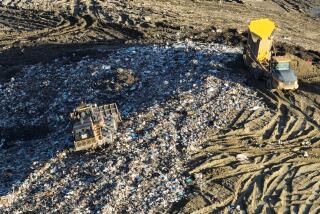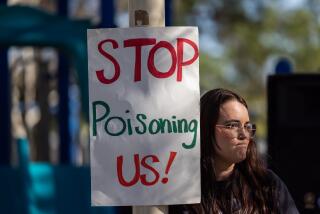The Environmental Scoop on Kitty Litter : It’s dusty, it’s dirty, but if you use some clumping brands correctly, it can be less of a mess. But you still can’t flush it.
- Share via
When I called the All Cats Clinic in Ventura, identified myself and said I was doing a report on cat litter, the receptionist responded cheerily, “Oh, so you won the office pool and got the big story. Well, our vet’s just the expert you’re looking for.”
And indeed, the expert part was true. Dr. T. J. Bulgin, 25 years a local DVM, proved to be eloquent about the environment, cat litter and the connection between the two. He had things to say about our health, our noses and our domestic plumbing. At issue was the 2 1/2 billion pounds of cat litter Americans use annually--at a cost of $700 million, by the way.
The problem is, according to Bulgin, that we shouldn’t breathe the dust from any of the stuff, get it on our rugs and furniture, or flush it down the toilet. If properly used, the products themselves aren’t really the problem. But, because we are lazy, we just dump some ground clay, ground corncobs, peanut shells, pine sawdust and even pelletized recycled newspaper into a cat box--and don’t change it often enough. It gets filthy, dusty, stinky and then is borne about the house on little cat feet.
“It’s emphysema city if you have respiratory problems. And if there’s a pregnant women in the home and the litter goes untended for several days, exposure to the toxoplasmosis in cat droppings can harm a fetus,” said Bulgin.
*
The other lazy thing we do is flush the soiled litter down the toilet. “Plumbers love that. It keeps them in business,” Bulgin said. At his clinic he uses--and swears by--a brand called Ultra Clumping. It’s a coarse-grained, dust-free, volcanic mineral substance, which lies in the box waiting for solid and liquid waste, then surrounds, deodorizes it and turns it into solid lumps. These are then scooped into plastic bags and tossed into a dumpster--not flushed.
The mineral, called “swelling clay” was invented by an oil drilling engineer to seal well walls. I called the manufacturer, Booda Products in Gardena. According to their spokesperson, Craig Budrant, “the disclaimer just went on the package saying not to flush.”
Which is the case with all other clumping products, which now account for 40% of litter sales. But Bulgin doesn’t like the other clumping products because they are made from a powdery form of clay, he said, that is dust-producing.
Other substances made into cat litter--even environmentally friendly pelletized recycled newspaper--apparently behave no better in your drains, despite claims to the contrary.
At For Pet’s Sake, a store in Westlake Village, owner George Lucas warns customers to be careful not to flush any litter. Brands based on sawdust, newspaper and peanut shells are labeled safe to flush, “but you should use common sense,” Bulgin says.
Manufacturers report several Eastern cities have banned dumping cat litter into toilets. But when Earthwatch contacted the Ventura Regional Sanitation District, operations manager Chuck Roger reported no cat litter accumulations at his waste water treatment facility.
At the Ventura County Solid Waste Management District, analyst David Goldstein reports no problems caused by litter in local landfills, “but keep it out of your compost pile--put it in the garbage. Cats are meat-eating animals and their droppings aren’t suitable for composting.”
Complicating everybody’s life in this $700-million arena has been the arrival in the supermarkets of Heartland Wheat Litter. It’s organic, it’s a renewable resource, it’s composed of soluble vegetable material the consistency of powdered soup and will biodegrade in the drain system. It jumps on kitty’s leavings, deodorizes them and clumps them up for easy removal from the cat box just like the swelling clay--but it’s safe to flush.
My wife, a cat lover, swears by it, which, truth to tell, is how I came to be doing this big story. Anyway, in the world of publishing, cat topics draw more readership than most anything you can get in the office pool.
DETAILS
* FYI: The environmental thing to do with cat litter is to change it often but not flush any down the toilet where it can cause blockage. It’s OK to put it in the garbage--but not the compost pile because it’s animal material.
More to Read
Sign up for Essential California
The most important California stories and recommendations in your inbox every morning.
You may occasionally receive promotional content from the Los Angeles Times.










